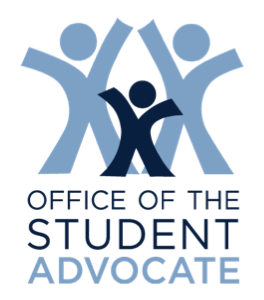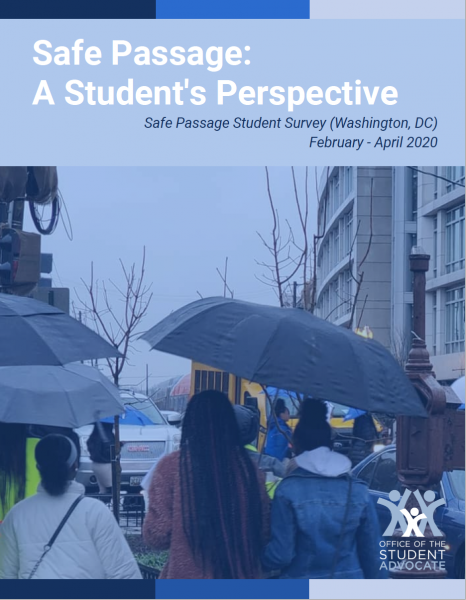The safe passage for our students, as they travel to and from school, is of the utmost importance to us all. Each year, at various times of the year, we hear about incidents that occur regarding the safety of our students in transit – as they walk or commute by public transportation to school.
Student Safety: A Student's Perspective
Student Safety & Safe Passage Surveys (Washington, DC) School Year 2023 - 2024 (Released 2025)
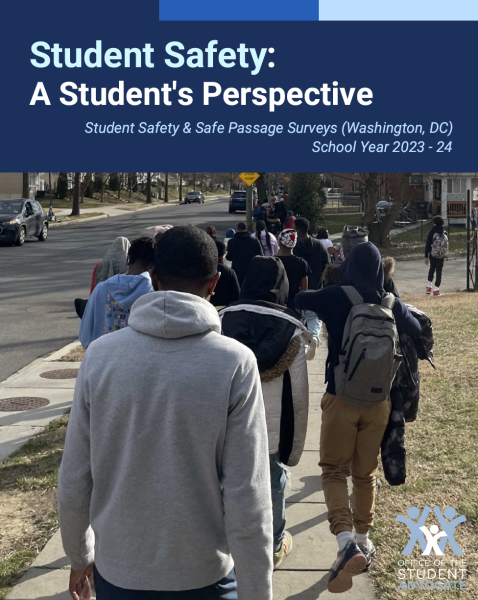 Following a spike in violent crime, in School Year 2023-24, the Office of the Student Advocate spoke with students, families, school staff and community organizations. The District responsed with multiple initiatives and investments, which has led to year-over-year decrease in violent crime in 2024 and to date in 2025. However, we are all a sum of our experiences. For too many students, those experiences include victimization, harassment, and a loss sense of security when doing the right thing going to school. We hope this report continues to push forward student and family voices as the District translate its values and priorities into future neighborhood investments.
Following a spike in violent crime, in School Year 2023-24, the Office of the Student Advocate spoke with students, families, school staff and community organizations. The District responsed with multiple initiatives and investments, which has led to year-over-year decrease in violent crime in 2024 and to date in 2025. However, we are all a sum of our experiences. For too many students, those experiences include victimization, harassment, and a loss sense of security when doing the right thing going to school. We hope this report continues to push forward student and family voices as the District translate its values and priorities into future neighborhood investments.
The reflections shared by students and families were captured during SY 2023. Since then, the city has implemented changes to help address safety concerns. The Safe Passage, Safe Blocks program has identified 12 priority areas for monitoring by Safe Passage Ambassadors. They have released an interactive map that identifies the covered routes so students and families can confidently plan their journey to and from school. School leaders, Metropolitan Police Department, District Department of Transportation, and Metro Transit police convene regularly “to discuss student safety concerns, plan assistance that is provided to areas, and share strategies for improving safety” (safe passage citation). Washington Metropolitan Area Transit Authority (WMATA) has continued to implement improvements as part of their 5 year strategic plan. Since this report was published, there has been a 9.1 percent decrease in crime from the start of SY 2024 - 25 compared to the same time last year. We look forward to capturing how students and families perceptions of safety shift as a result of these positive changes in the next iteration of our Safety Report.
Student Safety & Safe Passage Surveys (Washington, DC) School Year 2021 - 2022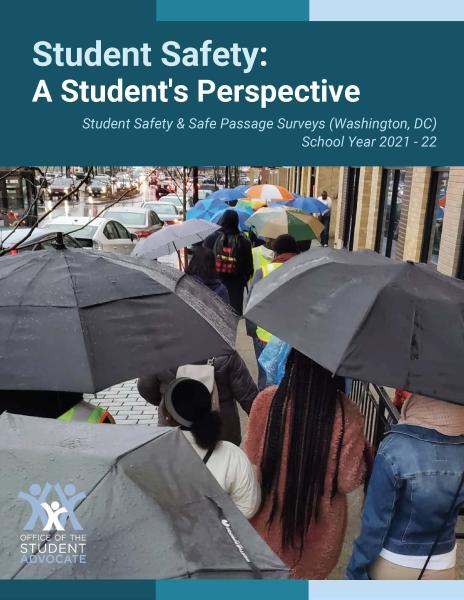
In 2021, the Office of the Student Advocate (OSA) administered surveys and conducted focus groups with students to better understand their experiences traveling to and from school. Our office anticipated a surge in incidents related to student safety due to multiple factors affecting students return to the classroom such as increasing levels of community violence, and decreased socialization skills from pandemic isolation. Sue to these concerns, we collaborated with the Urban Institute to survey more than 430 students to start the school year about their safety concerns. We were able to learn more about how students felt while traveling to and from school using various forms of transportation. As the school year progressed, we did see a spike in concerns related to student safety emerge.
In response to these growing concerns, our office restarted our in-person focus group discussions from before the pandemic. We expanded these discusssions to include middle school students, the families of elementary aged children, and English language learning students and families. We continued to work with youth leadership organizations like Pathways 2 Power and Mikva DC, while expanding our partnerships with community based organizations like Collaborative Solutions for Communities. In addition to learning more about their experiences traveling to and from school, we used these discussions to learn how students and families feel about current Safe Passage programming.
Safe Passage: A Student's Perspective
Safe Passage Student Survey (Washington, DC) February - April 2020
In 2020, OSA administered surveys and conducted focus groups with students to better understand their experiences traveling to and from school. OSA collaborated with the Urban Institute to provide analysis of select data from the survey results. More than one-third of students reported feeling uncomfortable or in danger. When asked more specifically about their level of safety, more than half of the respondents reported feeling either uncomfortable, concerned, afraid, or in danger while traveling to-and-from school. This analysis explores what make them feel that way and whether that varies across ward of residence.
Safe Passage Community Resources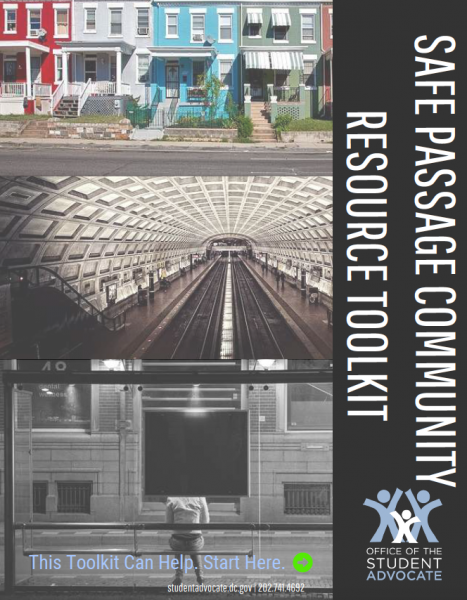
Safe Passage Community Resource Toolkit
Safe Passage Social Media Campaign
Safe Passage Working Group
Because of our work with families and communities, the Office of the Student Advocate recognized a need to join the efforts around the safe passage and support collaborative actions. The focus of this initiative was focused on offering support the policy-solution work of the Office of the Deputy Mayor Education (DME)1 with the inclusion of the parent, student, and community voice in order to address the issues in a more comprehensive and collaborative way. To meet this need, we established a Safe Passage Community and Collaboration Working Group comprised of government agencies, leaders of community-based organizations, and administrators of public education governance systems. These members represent a cross-section of stakeholders with scope and influence to impact the system while also providing parent and community voices themselves.
In our work, we navigate this issue by framing the definition of safe passage, and context for proactive solutions, in ways that apply directly to the context of the District of Columbia and our very unique education landscape. Safe Passage entails ensuring safe transport for students to and from schools. It also encompasses young people finding ‘safe passage’ from early childhood to young adulthood. Addressing this reoccurring issue requires a multipronged, collaborative approach that is inclusive of not only the definitional lens of safe passage, but most importantly supports student, parent, and community voices in the process.
Working Group Members
Office of the Student Advocate (DC State Board of Education) | Office of the Deputy Mayor for Education | Office of the Deputy Mayor for Public Safety & Justice | Office of Family & Public Engagement (DCPS) | Mayor’s Office of Community Relations & Services | DC Public Charter School Board | Citywide Youth Bullying Prevention Program (Office of Human Rights) | Parents Amplifying Voices in Education (PAVE) | Man the Block (Richard Wright Public Charter School) | Collaborative Solutions for Communities | Roving Leaders (DC Department of Parks & Recreation) | Division of Health & Wellness (OSSE)
Working Group Deliverables
- Cross-Jurisdictional Review of safe passage programmatic best practices and components.
- Analysis of Existing DC Safe Passage programs based on the 6 E’s prescribed by the National Center for Safe Routes to School (Education, Encouragement, Engineering, Enforcement, Evaluations, and Equity)
- Community Surveying with the goal of capturing, sharing and amplifying community voice regarding issues of safe passage.
- School-facing survey on sage passage challenges, needed supports, and relevant contacts
- Dialogue-centered community surveying in high-traffic areas. Questions include: (1) How do parents and students feel about safe routes? (2) What are the transportation or safety concerns? (3) How can they be communicated with schools, district leaders, elected officials, community organizations, law enforcement?
- Safe Passage Resource Toolkit – a compilation of resources for families, schools and communities to create and sustain the safe passage of our students and communities based on the 6 E’s from National Safe Routes to School.
- Social media campaign supporting safe passage. We have initiated a social media campaign to engage all community members in supporting our students and #DCSafeRoutes within our neighborhoods.
1Bill 21-669 drafted by the Council of the District of Columbia tasks the Deputy Mayor of Education (DME) to report on safe passage systems by October 1, 2016. The DME must submit “a proposed plan for schools where students are suffering from safe passage issues of bullying, violence, or other impediments to getting to and from school and recommendations for best practices for improved safe passage policies that schools can adopt.”
http://dccouncil.us/files/user_uploads/budget/B21669FY17BudgetSupportActof2016draftprintclean.pdf
